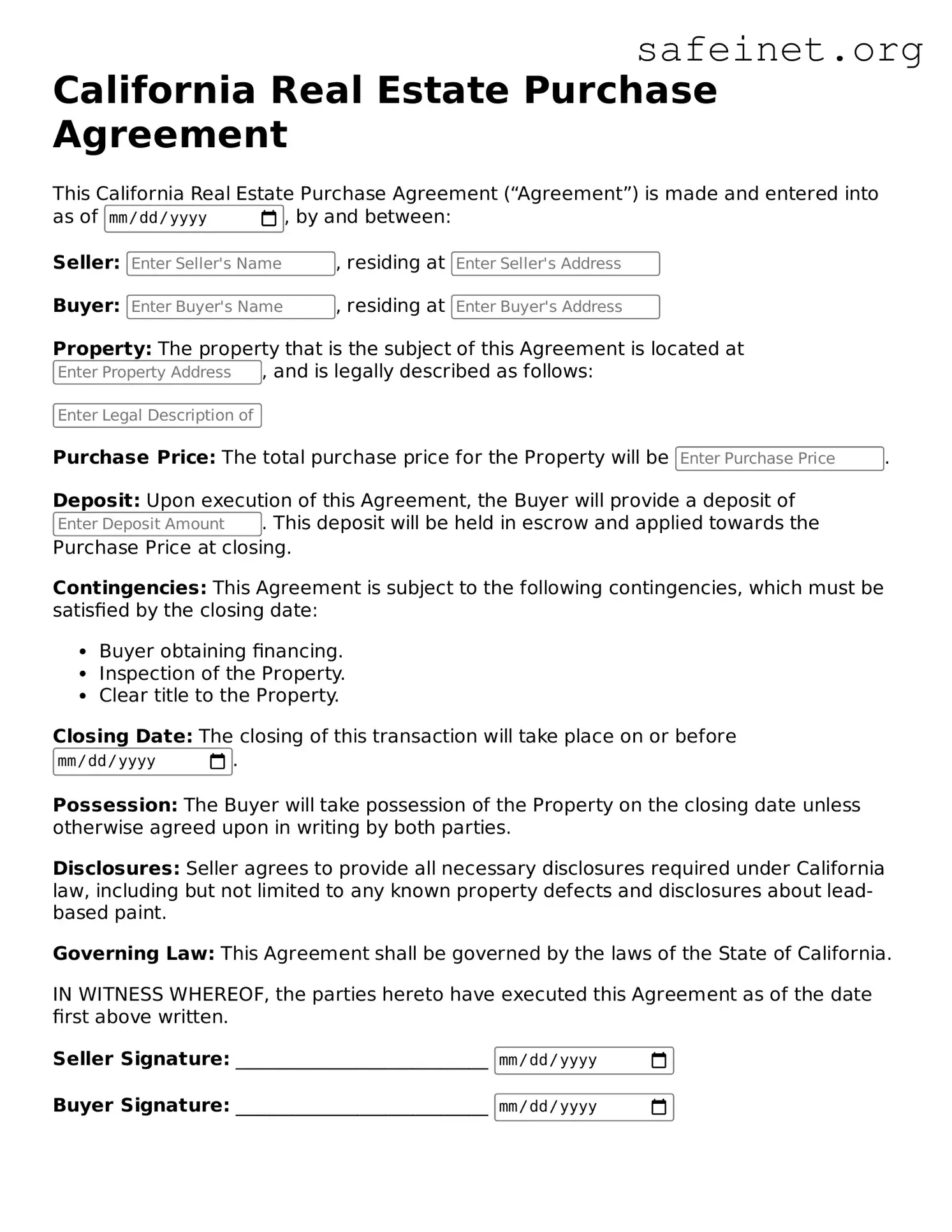The California Residential Purchase Agreement is similar to the Residential Lease Agreement in terms of defining the terms of a real estate transaction. While a purchase agreement is utilized for the sale of property, a lease agreement outlines the terms for renting or leasing a property. Both documents detail essential elements like the purchase or rental price, timelines for payment, conditions for maintenance, and the responsibilities of both parties. Each form aims to protect the rights and interests of the involved parties, establishing legally binding commitments.
The California Real Estate Purchase Agreement has parallels with the Commercial Purchase Agreement. This document serves a similar function but focuses specifically on commercial properties. Both agreements stipulate the price and specifics of the property being sold, along with clauses regarding contingencies, inspections, and the closing process. The primary difference lies in their applicability, with one used for residential properties and the other for commercial real estate transactions.
A Memorandum of Understanding (MOU) can also resemble the Real Estate Purchase Agreement in certain scenarios. An MOU outlines the preliminary terms and understanding between parties before final agreements are formalized. Although not legally binding in most cases, it expresses each party’s intentions and important terms they agree upon, which can later influence the final purchase agreement.
The Option to Purchase Agreement is another document that shares similarities with the Real Estate Purchase Agreement. This document grants a buyer the right to purchase a property at a predetermined price within a specific timeframe. Like a purchase agreement, an option agreement includes terms regarding price and conditions, allowing for buyer flexibility. If the buyer chooses to exercise their option, the terms outlined in the original agreement will govern the sale.
The Escrow Agreement closely relates to the Real Estate Purchase Agreement as both deal with the sale process, albeit at different stages. An escrow agreement is established to hold funds and documents during the purchase transaction until all conditions are met. The escrow officer coordinates the transaction, ensuring that all parties fulfill their obligations before completing the sale. This document typically references the terms of the purchase agreement while serving its purpose in the escrow process.
An Installment Sale Agreement can be likened to the Real Estate Purchase Agreement by providing a method for purchasing property over time. This type of agreement allows buyers to make payments in installments rather than a lump sum payment. It outlines the purchase price, payment schedule, and any interest owed, similar to how a standard purchase agreement details payment terms and conditions.
The Lease-to-Own Agreement bears similarity to the Real Estate Purchase Agreement by combining the aspects of renting and purchasing. In a lease-to-own agreement, a tenant rents a property with the option to purchase it later, often applying a portion of the rent toward the purchase price. Like the Real Estate Purchase Agreement, this document covers both rental and purchase terms, providing a structured way for tenants to eventually own the property.
An Addendum to a Purchase Agreement also reflects a close association with the Real Estate Purchase Agreement. When changes or additional terms need to be documented after the original purchase agreement, an addendum serves to outline those modifications clearly. It essentially acts as a supplement to the original agreement, ensuring all parties are informed of any adjustments in the terms of the sale.
The Real Estate Listing Agreement is related as it involves the sale process, focusing on the arrangement between a seller and a real estate agent. This document authorizes the agent to market the property, establish a sale price, and manage offers. While not a purchase agreement itself, it plays a crucial role in initiating the eventual sales process laid out in the purchase agreement.
Finally, a Purchase Money Mortgage Agreement connects to the Real Estate Purchase Agreement in its role involving financing. When a buyer finances their purchase directly through the seller, a purchase money mortgage agreement outlines the loan terms provided for the property. This agreement details the payment schedule, interest rates, and conditions, which closely aligns with the financial obligations highlighted in the purchase agreement.
